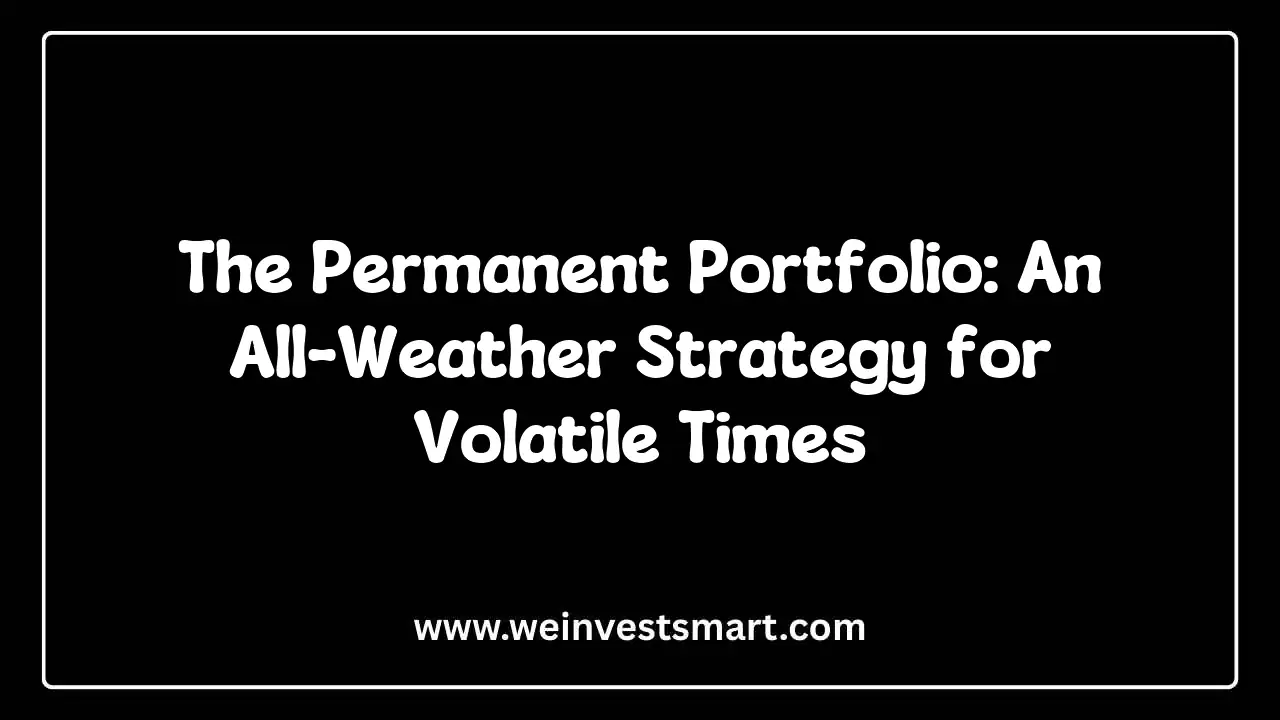· WeInvestSmart Team · investment-strategies · 9 min read
The Ultimate Guide to Rebalancing Your Portfolio
Discover the most counterintuitive—and powerful—habit in investing. This guide explains why and how to rebalance your portfolio, the disciplined act of selling your winners to buy your losers, to manage risk and enforce a “buy low, sell high” strategy.
Human intuition is a wonderful tool for navigating the world, but when it comes to investing, it’s a catastrophic liability. Our brains are hardwired to do one thing: chase what’s working and flee from what’s not. We see a stock soaring and our instincts scream, “Buy more!” We see another asset languishing and our gut tells us to “cut it loose.” But here’s the uncomfortable truth: this very intuition is the primary reason most investors dramatically underperform the market over their lifetimes.
Going straight to the point, one of the most powerful and effective habits of successful long-term investing requires you to do something that feels completely wrong. It requires you to systematically sell your winners and use the proceeds to buy more of your losers. This process is called rebalancing.
This sounds like a trade-off, but it’s actually the bedrock of disciplined investing. It’s the only mechanism that forces you to obey the oldest rule in finance: buy low and sell high. Here’s where things get interesting. Rebalancing isn’t about chasing higher returns; it’s about managing the one thing that will ultimately determine your success: risk. And this is just a very long way of saying that you need to fire your emotional gut as your portfolio manager and hire a cold, rational system instead.
The Slow, Silent Killer: Portfolio Drift
To understand why rebalancing is non-negotiable, we need to go to the heart of a problem that most people don’t even know they have: portfolio drift. Let’s imagine you’re a balanced investor who has wisely decided on a 60% stock and 40% bond asset allocation. You set it up, automate your contributions, and then you leave it alone for five years.
During those five years, the stock market goes on a tear, delivering fantastic returns, while the bond market plods along with modest gains. What happens to your portfolio? Your original 60/40 mix is long gone. Because your stocks grew so much faster, they now make up 75% or even 80% of your total portfolio.
The funny thing is that you’d probably feel great about this. Your account value is way up! But you have unknowingly become a much more aggressive investor than you ever intended to be. Your carefully constructed “balanced” portfolio is now a high-risk, stock-heavy portfolio, and you are dangerously exposed to the next stock market crash. This is portfolio drift, and it’s a silent killer because it feels good while it’s happening. Rebalancing is the cure.
What Rebalancing Is (and What It Isn’t)
Going straight to the point, rebalancing is the disciplined process of realigning your portfolio back to its original target asset allocation. In our 60/40 example, it means selling off some of that overgrown stock position and using the cash to buy more bonds until the portfolio is back to its 60/4- blueprint. You are trimming the asset that has performed well and is likely overvalued, and buying the asset that has underperformed and is likely undervalued.
It is critical to understand what rebalancing is not.
- It is not market timing. You are not making a prediction that stocks are about to fall. You are simply sticking to a predetermined plan.
- It is not a strategy for maximizing returns. While it can sometimes boost returns, its primary purpose is risk control. A rebalanced portfolio will almost certainly underperform a 100% stock portfolio in a raging bull market, and that’s okay. Its goal is to give you a smoother ride and protect your capital during the inevitable downturns.
- It is not an emotional decision. This is the key. Rebalancing is a cold, mechanical, rules-based action. It forces you to be disciplined when your emotions are telling you to do the exact opposite.
The Two Main Methods of Rebalancing
So, what do we do? How do we implement this in the real world? And here is where things get interesting. There are two primary schools of thought on how to trigger a rebalancing event.
1. Time-Based Rebalancing (The Calendar Method)
This is the simplest approach. You choose a set interval—for example, annually, semi-annually, or quarterly—and on that date, you review your portfolio and make the necessary trades to get back to your target allocation. The most common interval is annual. This has the advantage of being simple to remember and execute. It also helps to minimize trading, which can be beneficial in taxable accounts where selling winners triggers capital gains taxes. The downside is that a calendar-based approach might not react quickly enough if a major market move happens right after your rebalancing date.
2. Percentage-Based or Threshold Rebalancing (The Trigger Method)
This method is more proactive. Instead of a date on the calendar, you set “rebalancing bands” or thresholds around your target allocations. For example, with your 60/40 portfolio, you might set a 5% trigger. This means you will only rebalance when your stock allocation drifts up to 65% or down to 55%. If it stays within the 55%-65% range, you do nothing. This approach ensures you are only acting when the portfolio has drifted by a meaningful amount, potentially leading to fewer trades than a quarterly schedule but more responsiveness than an annual one. The downside is it requires you to monitor your portfolio more closely.
For many investors, a hybrid approach works best: review the portfolio on a set schedule (e.g., annually), but only rebalance if the thresholds have been breached.
A Practical Step-by-Step Guide to Rebalancing
Alright, let’s get practical. Here’s how you actually execute a rebalance.
Step 1: Know Your Target Allocation You cannot rebalance if you don’t have a blueprint. This is your desired mix of asset classes (e.g., 50% U.S. Stocks, 20% International Stocks, 30% Bonds). Write it down.
Step 2: Determine Your Current Allocation Log into your investment account(s) and calculate the current value of each asset class. A simple spreadsheet can help. Add up the total value of your portfolio and then divide the value of each asset class by the total to get your current percentage breakdown.
Step 3: Compare Your Current Mix to Your Target Identify which asset classes are overweight (above their target percentage) and which are underweight (below their target percentage).
Example:
- Target: 60% Stocks, 40% Bonds
- Current: 70% Stocks, 30% Bonds
- Analysis: Stocks are overweight by 10%, and bonds are underweight by 10%.
Step 4: Execute the Rebalancing Trades You have two primary ways to do this:
- Option A: Sell and Buy (The Classic Approach): Sell enough of the overweight asset class (stocks, in our example) to bring it down to its target percentage. Then, use those proceeds to buy the underweight asset class (bonds) until it reaches its target. This is the most direct method, but be mindful of taxes if you are doing this in a taxable brokerage account.
- Option B: Use New Contributions (The Tax-Efficient Approach): This is often a better method. Instead of selling anything, you simply direct all your new investment money towards the underweight asset class. In our example, you would stop buying stocks for a while and allocate 100% of your new contributions to bonds until the portfolio naturally drifts back to its 60/40 target. This avoids triggering capital gains taxes and is a very effective strategy for those who are still in the accumulation phase of their investing journey.
The Bottom Line: Your Best Defense Against Yourself
Rebalancing is the ultimate act of financial discipline. It’s the mechanism that protects your portfolio from two major threats: the external threat of unmanaged risk and the internal threat of your own emotional instincts. It’s an admission that we don’t know what the future holds, and therefore, the wisest course of action is to stick to a rational plan.
This process will feel wrong at times. Selling the assets that have made you the most money to buy the ones that have gone nowhere is deeply counterintuitive. But it is the very definition of buying low and selling high. It’s a simple, rules-based system for enforcing the discipline that separates successful long-term investors from the rest of the pack.
And this is just a very long way of saying that your investment plan is only as good as your ability to stick with it. Rebalancing is the single most powerful tool you have to ensure that you do just that. You get the gist: build a blueprint, and then have the discipline to maintain it, especially when it feels hardest.
This article is for educational purposes only and should not be considered personalized financial advice. Consider consulting with a financial advisor for guidance specific to your situation.
Portfolio Rebalancing FAQ
What is portfolio rebalancing?
Portfolio rebalancing is the process of realigning the weightings of a portfolio’s assets. In other words, it involves periodically buying or selling assets in your portfolio to maintain your original desired level of asset allocation and risk.
Why is rebalancing important?
Rebalancing is crucial for managing risk. As some assets outperform others, your portfolio’s original asset mix will drift, potentially making it much riskier than you intended. Rebalancing forces you to systematically sell high and buy low, imposing discipline and keeping your portfolio aligned with your long-term financial goals.
How often should I rebalance my portfolio?
There are two main approaches. Time-based rebalancing involves reviewing your portfolio at set intervals, such as annually or semi-annually. Percentage-based (or threshold) rebalancing involves rebalancing only when an asset class drifts by a predetermined percentage (e.g., 5%) from its target. A combination of both is often a good strategy.
Does rebalancing increase returns?
Not necessarily. The primary goal of rebalancing is risk management, not return maximization. While it can sometimes enhance returns by forcing you to buy assets at low prices, its main benefit is preventing your portfolio from becoming too concentrated in overvalued assets and ensuring it matches your risk tolerance.
Are there any tax implications when rebalancing?
Yes, in a taxable brokerage account, selling assets that have appreciated in value will trigger capital gains taxes. In tax-advantaged accounts like a 401(k) or an IRA, you can rebalance without any immediate tax consequences. It’s often best to rebalance using new contributions or within tax-sheltered accounts first.



